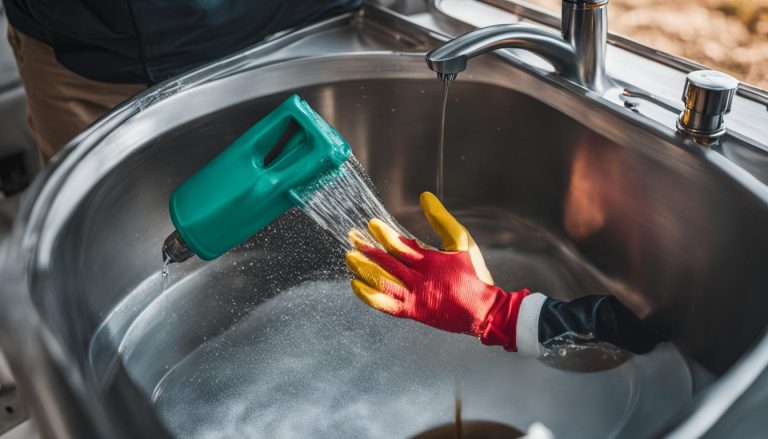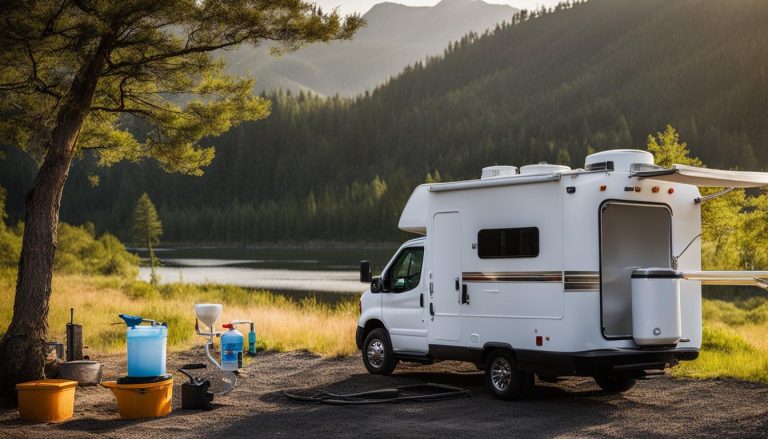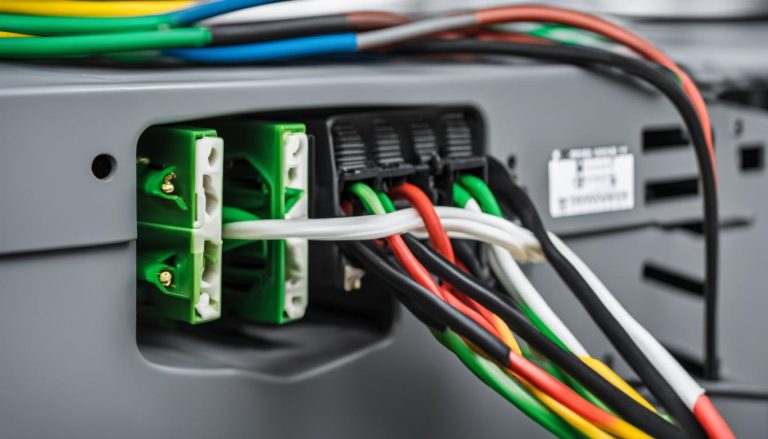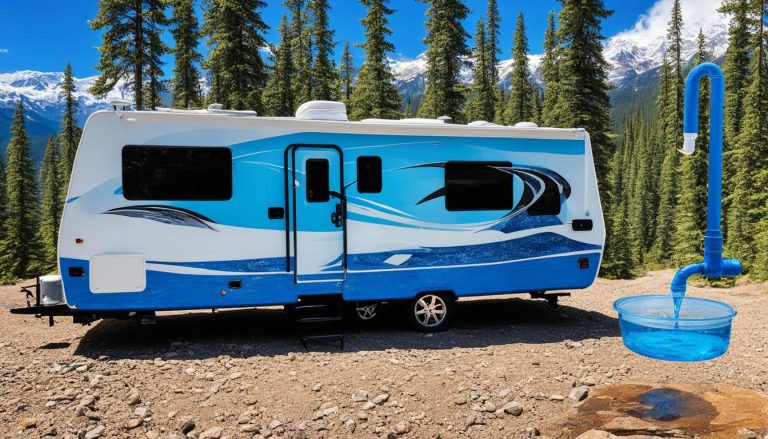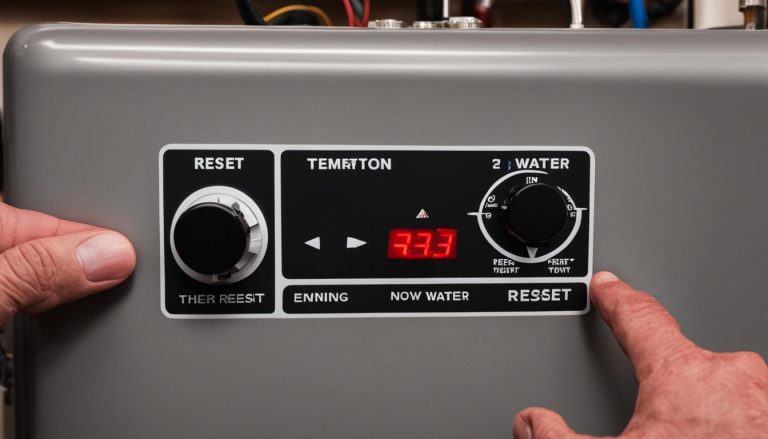Easy Steps on How to Close Awning on RV
gorvlifestyle.com and its partners may earn a commission if you purchase a product through one of our links
Closing the awning on your RV is a simple process that can help protect your awning from damage and ensure its longevity. By following a few easy steps, you can retract your RV awning with ease and be on your way to the next adventure. Let’s take a look at the steps involved in closing your RV awning.
Key Takeaways:
- Loosen the rafter knobs on the awning support arms.
- Release the travel locks by squeezing the support tabs.
- Switch the ratchet mechanism to the roll-down position.
- Roll in the awning using the rod and pull strap.
- Slide the rafters up and lock them into place.
Precautions for Closing an RV Awning Safely.
When closing your RV awning, it’s important to take the following precautions to ensure safety:
- Always make sure to loosen the black knobs and release the travel locks before attempting to close the awning.
- Be cautious of any debris that may have collected on the awning and remove it before rolling it in.
- Never force the awning closed if it does not roll in smoothly, as this could cause damage.
- If you’re unsure about the process or if there are any issues with the awning, consult the owner’s manual or contact a professional for assistance.
To illustrate the importance of these precautions, consider the case of John Thompson, an RV owner who neglected to follow proper awning closing procedures. As he forcefully tried to retract his awning without loosening the knobs, he ended up damaging the mechanism, resulting in costly repairs. Learn from his mistake and prioritize safety when closing your RV awning.
Remember, a small mishap during the awning closing process can lead to significant damage and expenses. Take your time, follow the steps, and stay safe!
RV Awning Closing Safety Tips:
- Always inspect the awning for any signs of damage or wear before closing.
- Remove any loose or hanging objects from the awning to avoid entanglement.
- Ensure there are no pets or children near the awning during the closing process.
- Never leave the awning unattended while closing.
Following these precautions and tips will help you close your RV awning safely, minimizing the risk of accidents and damage. Remember, a little extra care goes a long way in preserving the lifespan of your RV awning and ensuring a worry-free outdoor experience.
Maintaining Your RV Awning for Longevity
To ensure the longevity of your RV awning, it’s important to properly maintain it. By following these simple tips, you can keep your awning in excellent condition for years to come.
Regular Inspection
Regularly inspect the awning fabric for any signs of wear or damage. Look for tears, fraying, or any areas that may need repair. If you notice any issues, make the necessary repairs promptly to prevent further damage.
Cleaning
Clean the awning fabric regularly to remove dirt, dust, and debris. Use a mild soap and water solution to gently scrub the surface. Avoid using harsh chemicals that could damage the fabric. Rinse thoroughly and allow the awning to air dry completely before retracting it.
Prevent Mold and Mildew
Keeping the awning dry when not in use is essential to prevent the growth of mold and mildew. If the awning gets wet, make sure to extend it fully and allow it to dry before closing it. This will help avoid any potential damage and maintain a clean and pleasant awning surface.
Lubrication
Regularly lubricate any moving parts of the awning, such as the rafter arms. Using a silicone-based lubricant, apply a small amount to the joints and moving components. This will ensure smooth operation and prevent any stiffness or friction that could potentially cause damage.
Secure Retractable Awning
When closing a retractable awning, make sure it is fully retracted and securely locked in place before traveling. This will prevent any unnecessary movement or damage during transportation.
Incorporating these maintenance practices into your routine will help extend the life of your RV awning, ensuring it continues to provide shade and comfort for your outdoor adventures.
Common Issues and Troubleshooting
If you encounter any issues when closing your RV awning, don’t worry! We’ve got you covered with some common problems and troubleshooting tips:
1. Awning Won’t Roll In Smoothly?
If your awning is not rolling in smoothly, the first thing to check for is any obstructions or debris that may be blocking its path. Clear away any objects or debris that you find and try rolling the awning in again. Sometimes it just takes a little cleaning to get things moving smoothly!
2. Ratchet Mechanism Issues
Inspect the ratchet mechanism of your awning for any signs of damage or misalignment. If you notice any issues, it may be necessary to adjust or repair the mechanism to ensure it operates properly. This can help resolve any difficulties in rolling in your awning.
3. Uneven Retraction
If your awning is retracting unevenly, it could be due to tension issues with the rafter arms. Check the tension on both arms and adjust as needed to ensure a balanced retraction. This will help prevent the awning from getting stuck or jammed during the closing process.
If you’re experiencing any other problems or if the issue with your awning persists, it’s best to consult the owner’s manual or contact a professional for assistance. They can provide expert advice and guidance to address your specific concerns.
| Problem | Troubleshooting Tips |
|---|---|
| Awning Won’t Roll In Smoothly | Check for obstructions or debris blocking the path. Clear away any objects and try again. |
| Ratchet Mechanism Issues | Inspect for damage or misalignment. Adjust or repair the mechanism as needed. |
| Uneven Retraction | Check tension on rafter arms and adjust for balanced retraction. |
Remember, troubleshooting these common issues can help you get your RV awning closing smoothly again. However, if you’re unsure or the problem persists, it’s always a good idea to seek professional assistance.
Tips for Awning Maintenance
To keep your RV awning in good condition, it’s important to prioritize regular maintenance. Follow these tips to ensure that your awning stays clean, functional, and free from damage.
- Clean the awning fabric: Regularly clean your awning fabric using mild soap and water to remove dirt, debris, and stains. Avoid using harsh chemicals as they can damage the fabric. Gently scrub the surface and rinse thoroughly. This will help maintain the appearance and prolong the lifespan of your awning.
- Inspect the awning hardware: Periodically inspect the hardware components of your awning, such as screws, joints, and arms. Look for any signs of wear, damage, or corrosion. Tighten loose screws and replace any damaged or faulty parts as needed to ensure the stability and functionality of your awning.
- Lubricate moving parts: Use a silicone-based lubricant to keep the moving parts of your awning, such as the rafter arms, operating smoothly. Apply the lubricant according to the manufacturer’s instructions to prevent squeaking, sticking, or jamming. This will promote easy extension and retraction of the awning.
- Ensure the awning is dry before storing: Before storing your awning, make sure it is completely dry to prevent the growth of mold and mildew. If the fabric is damp, open the awning and allow it to air out before retracting it. This will help preserve the quality of the fabric and prevent unpleasant odors.
- Consider using awning covers or sun shades: To protect your RV awning from excessive sun exposure, consider using an awning cover or sun shade. These accessories provide an extra layer of protection against UV rays and help extend the lifespan of the awning fabric. They also help to reduce heat buildup and provide additional shade.
Remember, proper maintenance of your RV awning is essential to ensure its longevity and functionality. Regular cleaning, inspection, and lubrication will help keep your awning in optimal condition, allowing you to enjoy shade and shelter during your outdoor adventures.
Refer to the table below for a summary of the tips for maintaining your RV awning:
| Tip | Description |
|---|---|
| Clean the awning fabric | Regularly clean with mild soap and water to remove dirt and debris. Avoid harsh chemicals. |
| Inspect the awning hardware | Periodically check for wear, damage, and loose components. Tighten screws and replace faulty parts. |
| Lubricate moving parts | Use a silicone-based lubricant on rafter arms and other moving parts for smooth operation. |
| Ensure the awning is dry before storing | Allow the awning to fully dry before retracting to prevent mold and mildew growth. |
| Consider using awning covers or sun shades | Protect the awning from excessive sun exposure with additional accessories. |
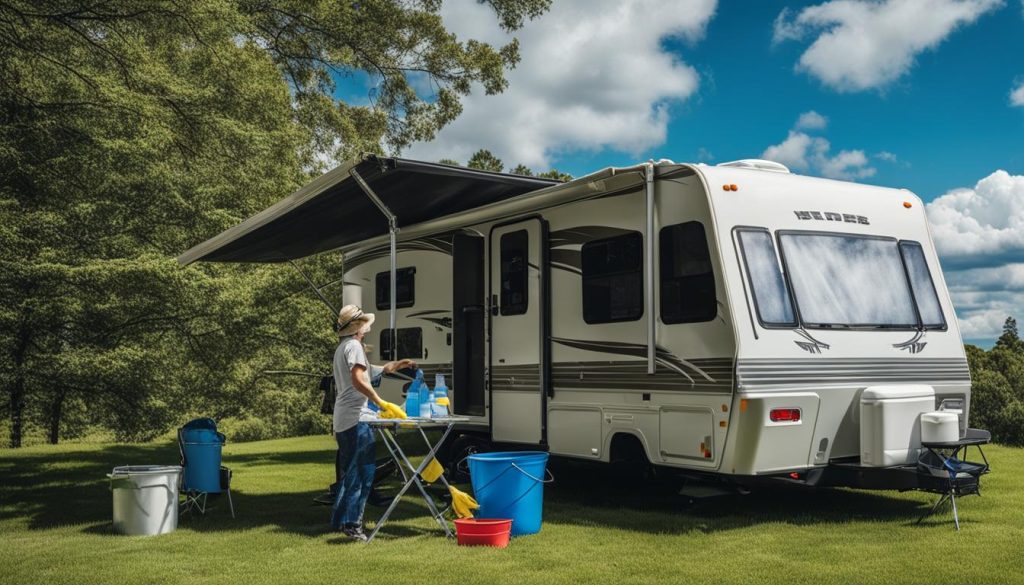
By following these maintenance tips, you can keep your RV awning in excellent condition, extending its lifespan and ensuring it provides reliable shade and protection for your outdoor adventures.
Important Safety Reminders
When dealing with RV awnings, it’s important to prioritize safety. Here are some important safety reminders:
- Never leave your awning open when you’re away from your RV or during inclement weather. Sudden gusts of wind or heavy rain could damage the awning. It’s best to be cautious and close the awning to prevent any potential harm.
- Make sure to secure the awning strap properly and keep it out of the way to prevent tripping hazards. A securely fastened strap will keep the awning in place and avoid accidents.
- If the weather conditions are unfavorable, such as high winds or storms, it’s best to retract the awning to avoid potential damage. Strong winds can cause the awning to sway or get damaged, so it’s advisable to retract it when bad weather is expected.
- Regularly inspect all components of the awning for any signs of wear or damage, and address any issues promptly. Keeping a close eye on the condition of your awning can help prevent accidents and extend its lifespan. If you notice any wear or damage, take immediate action to repair or replace the affected parts.
- If you’re unsure about any aspect of awning operation or maintenance, consult the owner’s manual or seek professional advice. It’s always better to seek guidance from the manufacturer or a professional to ensure that you’re following the correct procedures and avoiding any potential mistakes or risks.
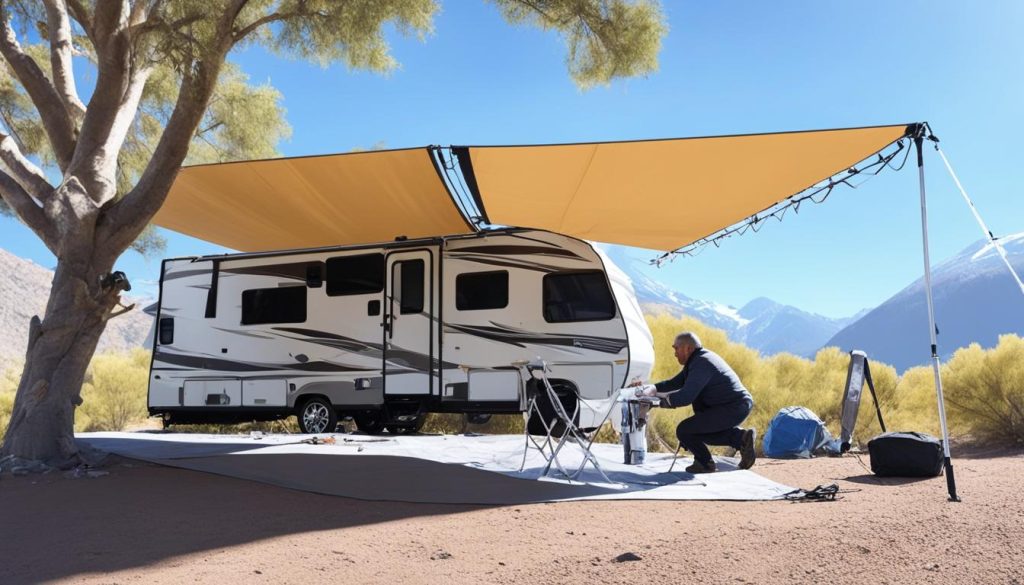
Conclusion
Closing the awning on your RV is a straightforward process, but it requires attention to detail and adherence to safety guidelines. By following the easy steps provided in this guide, you can ensure a smooth and hassle-free awning closing experience.
Remember to loosen the rafter knobs, release the travel locks, and switch the ratchet mechanism to the roll-down position. Roll in the awning carefully using the rod and pull strap until it is fully retracted. Secure the rafters in place and lower the outer awning arms. Finally, don’t forget to secure the strap to keep it out of the way.
Maintaining your RV awning plays a vital role in its longevity. Regularly inspect the fabric for any signs of wear, clean it to remove dirt and debris, and keep it dry when not in use. Lubricate moving parts and store the awning properly. Taking these steps will help you enjoy your awning for years to come.
Additionally, it’s essential to prioritize safety when dealing with your RV awning. Always retract the awning when you’re away from your RV or facing unfavorable weather conditions. Be vigilant about inspecting and addressing any wear or damage. If you have any questions or concerns, consult the owner’s manual or seek professional assistance.
FAQ
How do I close the awning on my RV?
To close the awning on your RV, follow these simple steps: loosen the rafter knobs, release the travel locks, switch the ratchet mechanism to the roll-down position, roll in the awning using the rod and pull strap, slide the rafters up and lock them into place, and lower the awning arms. Make sure to consult the owner’s manual or contact a professional for assistance if needed.
What precautions should I take when closing an RV awning?
When closing your RV awning, it’s important to take the following precautions to ensure safety: always loosen the rafter knobs and release the travel locks, be cautious of any debris on the awning, never force the awning closed if it doesn’t roll in smoothly, and consult the owner’s manual or contact a professional if unsure or if there are any issues.
How can I maintain my RV awning for longevity?
To ensure the longevity of your RV awning, it’s important to properly maintain it. Some tips for maintenance include regularly inspecting the fabric for wear or damage, cleaning it with mild soap and water, keeping it dry when not in use, lubricating moving parts, fully retracting and securing the awning before traveling, and considering using awning covers or sun shades for added protection.
What are some common issues with RV awnings and how can I troubleshoot them?
Some common issues with RV awnings include difficulty rolling them in smoothly, uneven retraction, and problems with the ratchet mechanism. To troubleshoot these issues, check for obstructions or debris blocking the awning’s path, inspect the ratchet mechanism for damage or misalignment, and adjust the tension on the rafter arms if needed. If the issue persists, consult the owner’s manual or contact a professional for assistance.
What are some tips for awning maintenance?
To keep your RV awning in good condition, regularly clean the fabric, inspect and repair any hardware damage, lubricate moving parts, ensure the awning is fully dry before storing, and consider using awning covers or sun shades for added protection from the elements.
What are some important safety reminders when dealing with RV awnings?
When dealing with RV awnings, it’s important to prioritize safety. Some important safety reminders include never leaving the awning open when away or during inclement weather, properly securing the awning strap to prevent tripping hazards, retracting the awning during unfavorable weather conditions, regularly inspecting the awning for wear or damage, and seeking professional advice if unsure about any aspect of awning operation or maintenance.
Conclusion – What are some key takeaways for closing an RV awning?
Closing the awning on your RV may seem like a simple task, but it’s important to follow the proper steps and take precautions to ensure safety and maintain the awning’s longevity. By following the easy steps outlined in this guide and staying vigilant about maintenance and safety, you can enjoy a hassle-free awning experience and make the most of your RV adventures. Remember to consult the owner’s manual or seek professional assistance if you encounter any issues or have any concerns.

